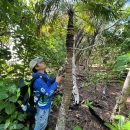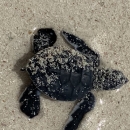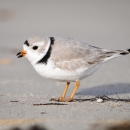States
GuamEcosystem
ForestThe Guam National Wildlife Refuge (Refuge) is home to several thousand federally threatened fadang (Cycas micronesica). The fadang is listed due to the impact of the cycad aulacaspis scale (scale), an invasive insect. The Refuge is working with the Cycad Working Group to develop a standard survey methodology. Using this methodology, the Refuge will assess the health of the fadang and the impact of the scale and other insects across the Refuge. This project is funded in part by the U.S. Forest Service's Biological Control of Invasive Forest Pests Program, which is part of the Forest Health Protection Program.
Background:
The fadang is a long-lived member of the cycad family (Cycadaceae) and is native to the islands of Guam, Rota, Pagan, Palau, and Yap2. The US Fish and Wildlife Service listed the species as threatened in 2015 due to the impacts of the cycad aulacaspis scale (Aulacaspis yasumatsui) (scale), which is an insect native to southeast Asia2. The scale is believed to have been accidentally introduced to the Mariana Islands via ornamental cycads2.
In 2017, the Refuge conducted a survey focused on the eastern side of the Refuge to determine the impact of four insects: the scale, the non-native cycad leafminer (Erechthias sp.), the non-native cycad blue butterfly (Chilades pandava), and a native stem borer (Dihammus marianarum)1. Kwak1 found 993 fadang within the study area with 992 fadang being infestated by at least one insect. A more dire discovery was that no juvenile or sapling fadang were discovered.
Project Need:
Due to the continued decline of the cycad throughout its range, Refuge staff wanted an updated accounting of the number of fadang and the impact by insects on the Refuge. Refuge staff also want to monitor the identified fadang on a yearly basis.
Goals and Objectives:
- Develop a robust monitoring program at the Refuge.
- Work with the Cycad Working Group to develop a standardized survey methodology, which will allow easier comparison of data from surveys throughout the fadang’s range.
(completed) - Develop a Standard Operating Procedure for collecting project information and to determine what materials will be needed. Using ArcGIS Online and Field Maps, develop a simplified data collection database.
- Work with the Cycad Working Group to develop a standardized survey methodology, which will allow easier comparison of data from surveys throughout the fadang’s range.
- Survey fadang throughout the Refuge.
- Using 10 meter-wide transects spread evenly throughout the Refuge and the standardized survey methodology, document 2,000 fadang’s health, the impacts of insects, and other pertinent information. Each fadang will be tagged with an aluminum tree tag for future identification.
- After baseline information has been collected, revisit several fadang periodically to document growth and decline.
Project Benefits:
Refuge staff are currently working with the Cycad Working Group to develop methods to control insects impacting the fadang. This project will help Refuge staff determine the impact of each insect, document new insects impacting the fadang, and determine where more intensive management needs to occur.
Additionally, Refuge staff will propagate fadang seeds and pups in the nursery for outplanting on the Refuge to enhance the native limestone forest. This project will help Refuge staff understand the different environmental characteristics across the Refuge and determine the natural density of the fadang with respect to these environmental characteristics.
Project Updates:
Update for 11/30/2024
The Kupu members and the Refuge biologist have tagged and collected data on an additional
whopping 835 fadang in the month of November, bringing the total to 1,785 fadang! Wowza! The biggest hurdle of the project is nearing its end as we approach 2,000 individuals.
Update for 11/15/2024
The Kupu members and the Refuge biologist have tagged and collected data on an additional
225 fadang in the month of October, bringing the total to 950 fadang!
The Refuge will be hosting a University of Guam COMPASS student; Josiah has joined the Cycad project. Welcome Josiah!
Update for 10/5/2024
The Kupu members and the Refuge biologist have tagged and collected data on 725 fadang!
Refuge staff, the Kupu members, and the Cycad Working Group have finalized the development of the standardized survey methodology (Goal 1 Objective a). We hope to start collecting data following this methodology soon.
Update for 8/24/2024
The Kupu members and the Refuge biologist have tagged and collected data on over 400 fadang, including one seedling!
Refuge staff and the Kupu members have been meeting with the Cycad Working Group to develop a standardized survey methodology.
Kupu member Tatiana Ananich left her position for an opportunity in Hawai'i. Thank you for everything, Tatiana!
Additionally, the acting Refuge Manager's, Chris Eggleston, detail ended in the middle of July. Chris was instrumental in helping to get this project off the ground by helping the Refuge biologist and Kupu members figure out the methodology. Thank you for all of your help, Chris!
Update for 7/1/2024
The Refuge is hosting three Kupu members, which one member, Josh Artuz, focusing solely on the Cycad Health Assessment project. The Kupu members have started recording the GPS location of each fadang on the Refuge using the data dictionary designed by Kwak1. Refuge staff had hoped to revisit the fadang identified by Kwak, but due to the age of the equipment used originally and the lack of tree tags, we are unsure which fadang is which. Therefore, we have decided to restart the numbering scheme.
Dångkulu na si Yu’us ma’åse’ to the following people:
Chris Eggleston - U.S. Fish and Wildlife Service
Joshua (Josh) Artuz - Kupu AmeriCorps
Matthew (Matt) Reardon - Kupu AmeriCorps
Tatiana Ananich - Kupu AmeriCorps
Josiah Urbano - University of Guam COMPASS
References:
- Kwak, Chalie C. 2017. Survey of Three Federally-Listed Tree Species on Guam National Wildlife Refuge: Final Report. Report to the U.S. Fish and Wildlife Service. 16 pages.
- U.S. Fish and Wildlife Service. 2015. Endangered and Threatened Wildlife and Plants; Endangered Status for 16 Species and Threatened Status for 7 Species in Micronesia. Federal Register 80: 59423-59497.









